Hop aboard and soak in the hues of autumn at Aizu, Fukushima
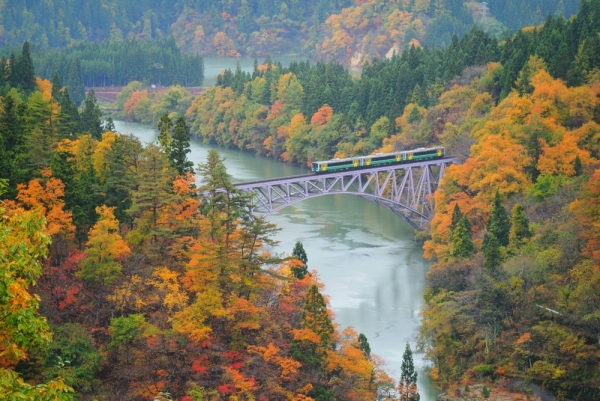
And so we’ve reached the 3rd and final chapter of our autumn trip to Tohoku. What kind of beautiful autumn views await us at the end of our journey? Hop on the train with us to find out! For those who’ve just joined us, feel free to read Part 1 (Yamagata) and Part 2 (Akita) to catch up with us.
Discover Fukushima in autumn with the FruiTea Fukushima

Exterior of the FruiTea Fukushima (Image credit: KrobkruengJapan)
One way to enjoy your trip in Japan is to hop aboard a special train like the FruiTea Fukushima. The special part of this train is that apart from mesmerising views you’ll see outside the windows, the train is decorated like a luxurious café. Furthermore, there will be desserts made from seasonal fruits along with your favourite cup of tea or coffee that will make your sightseeing trip sweeter than ever.

View of Mount Bandai from the window. (Image credit: KrobkruengJapan)
We started off at JR Kо̄riyama Station (郡山駅) and headed to JR Aizu-Wakamatsu Station (会津若松駅). While enjoying your desserts, you can relax with the views of mountains like the famous Mount Bandai, along with the views of rice fields, and red leaves. These elements alone are enough to make you enjoy your whole trip.
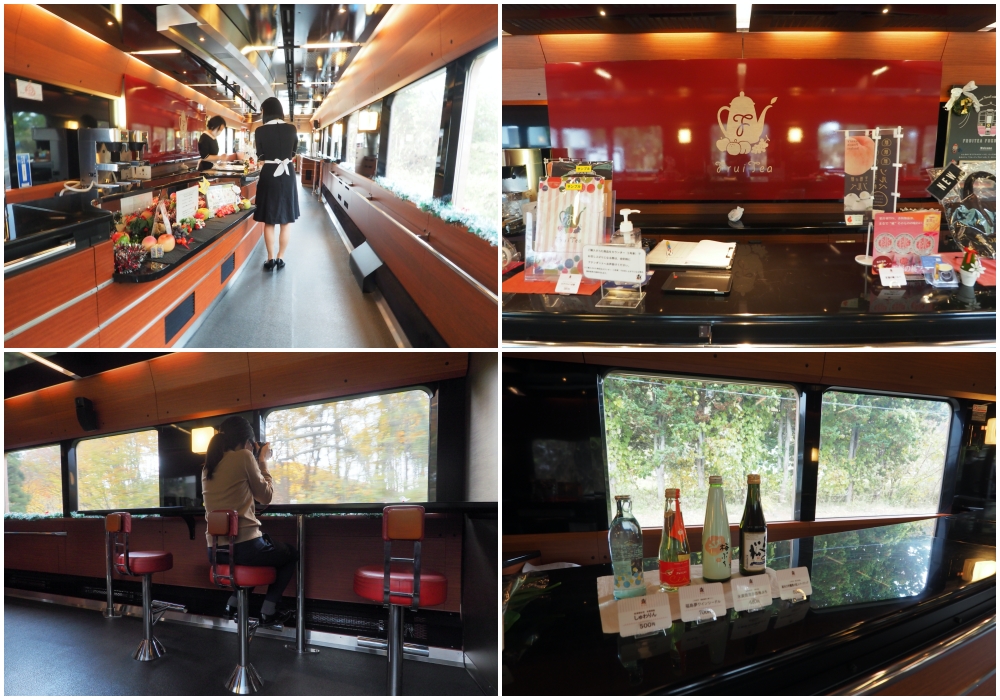
Inside Car 1. (Image credit: KrobkruengJapan)
Car 1 is a café counter car that has two counters lining along both sides of the car; you can sit wherever you like. There are also souvenirs and local snacks and drinks available for purchase in this car. Moreover, staff dressed in café waiter’s uniform will be there to serve and assist you warmly, allowing you to enjoy this special trip even more. (Note: Due to COVID-19, staff will serve the desserts and drink at your seat. Usually, the iced drinks are free flow, self-service from Car 1.)
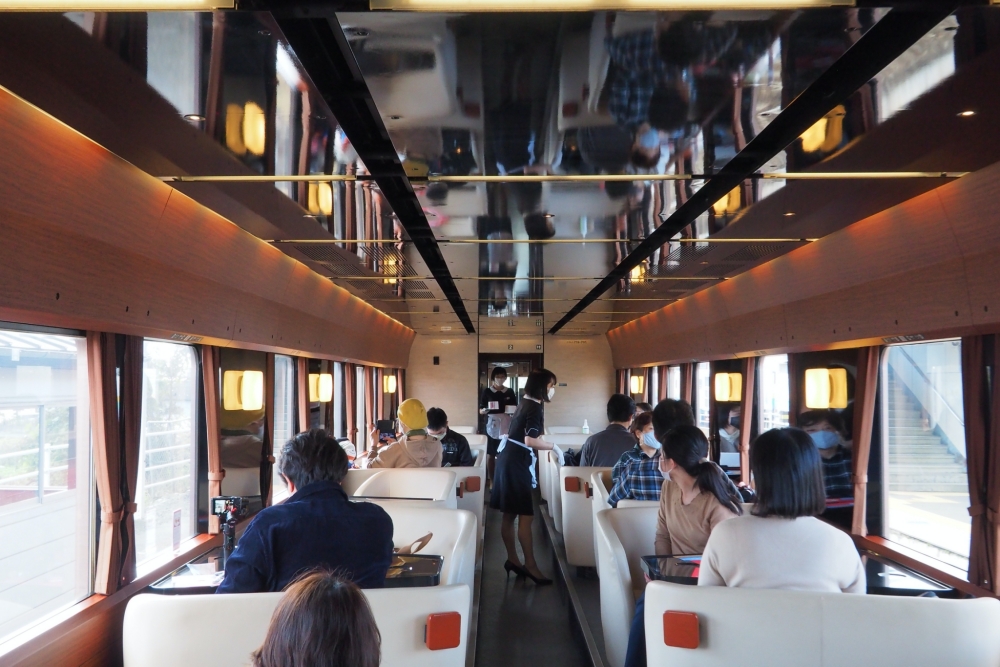
Seats in Car 2. (Image credit: KrobkruengJapan)
Car 2 is designed to serve as a comfortable café lounge. There are many types of seats in Car 2—seats for solo travellers, seats for couples, and seats for a group of four people. Whether you are alone, with your partner, or with your group, you can enjoy this train in your own way. Most importantly, there are spaces for you to stow your luggage, so don’t worry.

November's persimmon tarts on the FruiTea Fukushima (Image credit: KrobkruengJapan)
The interesting thing about FruiTea Fukushima is that all desserts that are served aboard the train are all made from seasonal fruits of Fukushima Prefecture. Be it strawberries, Japanese cherries, peaches, pears, grapes, persimmons, or others, prepare to treat yourself to Fukushima’s famous and delicious fruits.

Enjoying our desserts. (Image credit: KrobkruengJapan)
The desserts that we get to try on this trip are desserts made of persimmons, given that we were travelling in November which is the season of persimmon. Fukushima’s persimmons are famous to the extent that they are sent to the imperial court for the imperial family. Each set contained two desserts—custard cream tart and chocolate mousse tart. Both have persimmons as the main topping, sprinkled with a few other fruits like strawberries, blueberries, and grapes.
The desserts come with a glass of refreshingly sweet persimmon juice. The set also comes with other drinks like tea and coffee; there are no time limits, so feel free to order the drinks whenever you like. (Note: Due to COVID-19, staff will bring your drinks to your seat with a limit of three servings per person. In normal circumstances, you can refill your own drink as much as you like.)
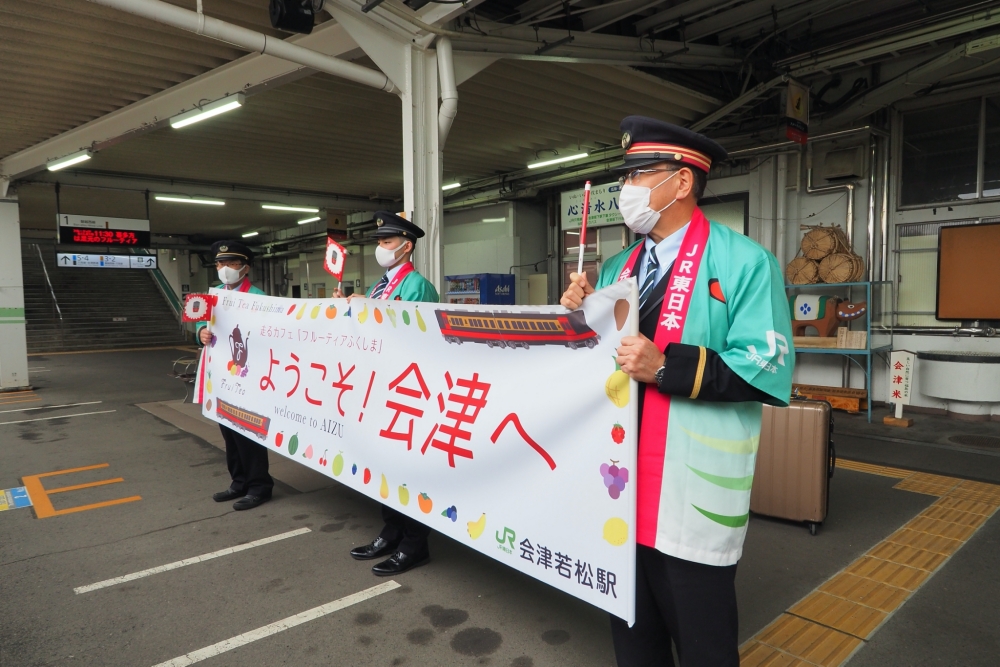
Staff holding a banner to welcome FruiTea Fukushima riders to Aizu-Wakamatsu Station. (Image credit: KrobkruengJapan)
A ride on the FruiTea Fukushima is only sold as a package, which includes the dessert set, train fair, and reserved seat fees. It costs around ¥4,800 from Kо̄riyama to Aizu-Wakamatsu, plus another ¥200 for those who travel alone. If you’re interested in an experience like no other, check out the train schedule here.
Ouchijuku, a former post town with a colourful backdrop
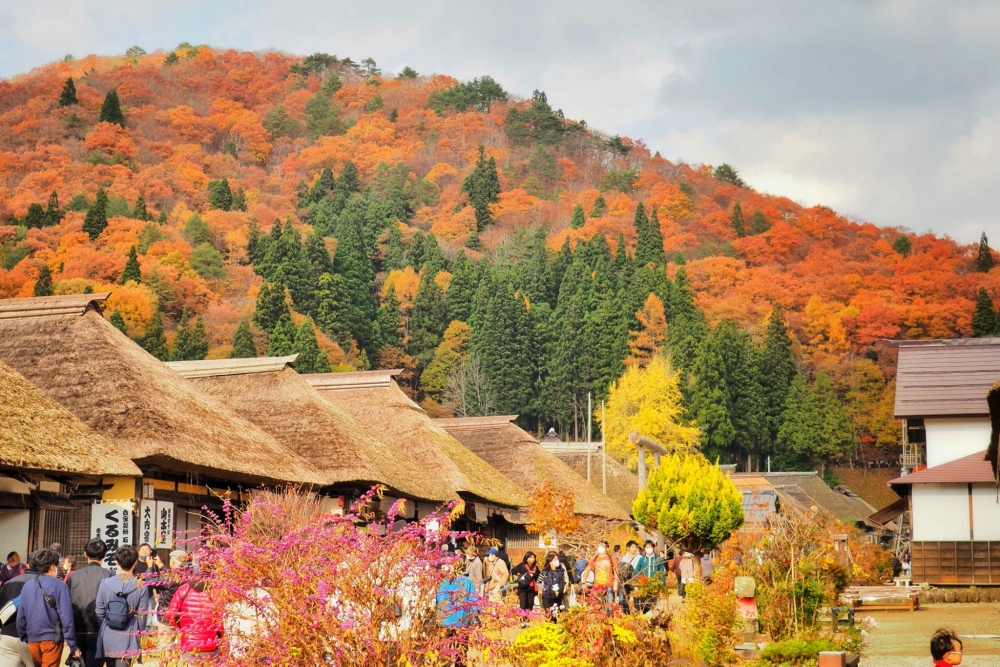
Ouchijuku in autumn. (Image credit: KrobkruengJapan)
Since we’re here in Aizu, we paid a visit to an old village in Fukushima called Ouchijuku (大内宿 О̄uchijuku). This village has been here since 1640 in the Edo Period (1603–1868) and served as a former post town for samurais and commoners alike. On their journeys, people often take a rest at this village, for it has food and all accommodations for travelers. The Aizu Nishi Kaidо̄ (会津西街道), the road that passed through Ouchijuku, was once considered a main trade route that connected the Aizu Domain of Fukushima Prefecture and Imaichi of Tochigi Prefecture.

Scenic views around Ouchijuku. (Image credit: KrobkruengJapan)
In 1981, Ouchijuku was designated as an Important Preservation District for Groups of Traditional Buildings. 40–50 houses from the Edo Period are preserved in this village. One thing you will notice is the houses here have a unique thatched roof (茅葺屋根 kayabuki-yane)—designed to prevent snow from accumulating on the roof and crushing the houses.
Among the houses here, some have been renovated into diners, souvenir shops, and accommodations. Tourists who love the sense of classic traditional Japanese will surely love it here. Furthermore, the village’s beauty differs in each season, so feel free to drop by whenever you like.

Ouchijuku from the sightseeing point. (Image credit: KrobkruengJapan)
When you’re here in Ouchijuku, don’t miss the chance to go to the sightseeing point. The way up might not be convenient due to its steepness. I don’t recommend it for the elderly, expecting mothers, and little children as accidents may happen. But if you’re able-bodied and fit to go, climb up the path. Despite bad weather, the scenery is nonetheless breathtaking; especially during autumn like this. The climb up is really worth it.

Misawaya is popular for its Negi Soba. (Image credit: KrobkruengJapan)
As for the must-try food of this village, I recommend Negi Soba (ネギそば). There are many diners that serve this particular soba, Misawaya (三澤屋) is one of them. Misawaya is a famous diner, as seen by the long line of customers waiting outside. The diner is decorated in a traditional Japanese style. With kotatsu, a table with a heater, to warm you up during winter.
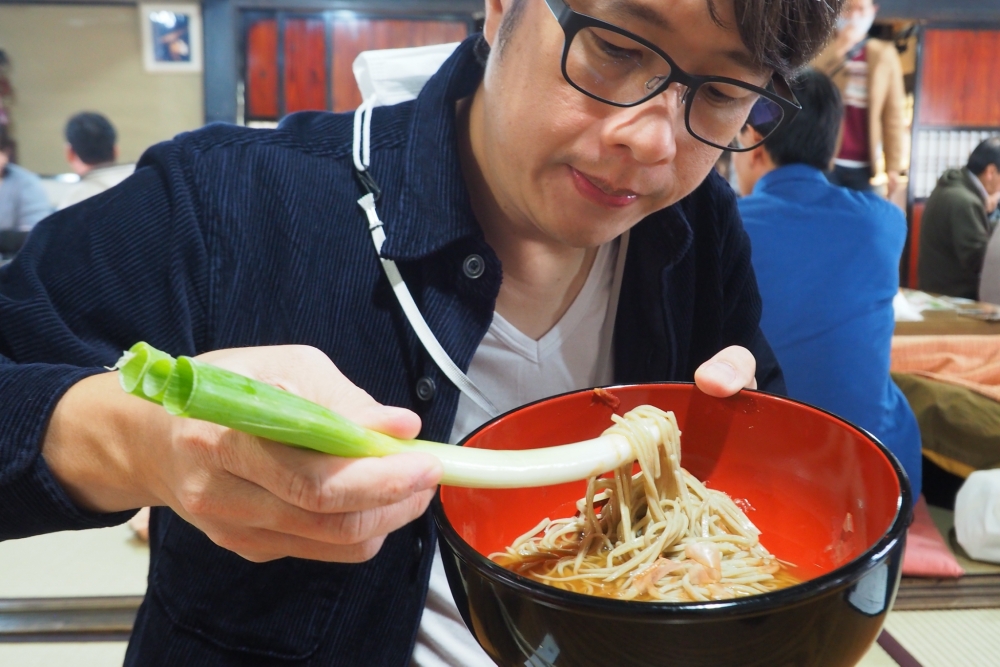
How to eat Negi Soba (Image credit: KrobkruengJapan)
Negi Soba, officially known as Takato Soba (高遠そば), is a dish loved by locals of Aizu. It is served with a giant leek which will be used as a spoon. You can savour the fragrance of the leek while eating it along with soba noodles. The end of the leek will be slightly curved like a ‘J’, allowing you to scoop up the noodles with ease. The Negi Soba costs around ¥1,320, and you can choose between hot and cold soup.
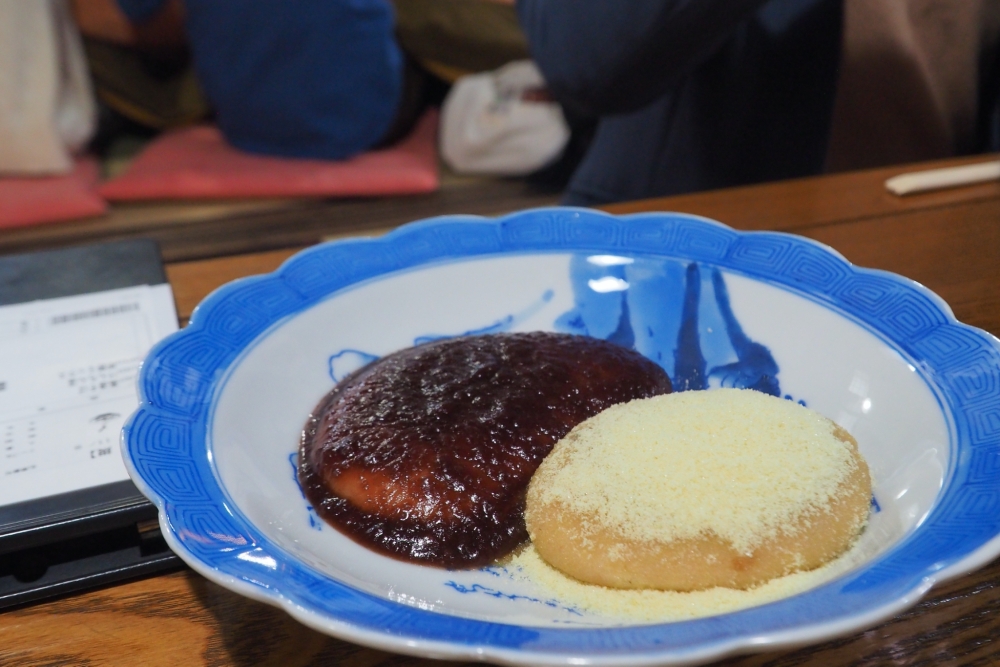
Mochi that comes in the set (Image credit: KrobkruengJapan)
If you like traditional Japanese desserts, I recommend red bean mochi and kinako mochi set which costs ¥660. Their texture is very soft and chewy, with a delightful sweetness.
Ouchijuku (大内宿)
Access: 20-minute bus ride from Aizu Railway Yunokami Onsen Station (湯野上温泉駅)
Admission fee: Free to enter the village and go up the viewpoint.
Soak your feet in onsen and enjoy the autumn view for free at Yunokami Onsen Station

The atmosphere at Yunokami Onsen Station (Image credit: KrobkruengJapan)
If you’re visiting Ouchijuku, you’ll definitely have to pass by Yunokami Onsen Station (湯野上温泉駅) in Yunokami, a small town that is best known for its onsen in Fukushima.

Enjoying the foot bath and autumn views (Image credit: KrobkruengJapan)
Apart from its vintage architecture and old-style thatched roof (same as the ones at Ouchijuku), this station also has foot bath (足湯 ashiyu) available for free. Soak your foot in the warm water and bask in the beautiful autumn scenery. You will also get a chance to see trains with cute decorations passing by. Nothing beats a short break like this.
Yunokami Onsen Station (湯野上温泉駅)
Access: 30-minute ride on the Aizu Railway Aizu Line from Aizu-Wakamatsu Station (会津若松駅)
Step into samurai houses at Aizu Bukeyashiki

Aizu Bukeyashiki (Image credit: KrobkruengJapan)
A trip in Aizu will not be complete if you don’t visit Aizu Bukeyashiki (会津武家屋敷). The term bukeyashiki (武家屋敷) means “samurai residence”. The houses that we’re visiting here belonged to a famous aristocratic samurai named Saigō Tanomo, and another house was an old residence named Kyū Nakahata Jin’ya (旧中畑陣屋跡), which is designated as Fukushima’s cultural treasure.

A tour inside Aizu Bukeyashiki (Image credit: KrobkruengJapan)
You can find a tea room, rice mill, and rooms for each member of the household; along with mannequins that replicate the livelihood of the people in that period. Walk further inside, and you’ll find a museum that keeps historical records and arts, including a souvenir shop.

Complete the tour by admiring the colours of autumn (Image credit: KrobkruengJapan)
After you’ve finished your tour inside the house, step outside and view the maple trees that clad themselves with red leaves. A great final touch to experience the charming beauty of a samurai house.
Aizu Bukeyashiki (会津武家屋敷)
Address: 1 Aza Innai, Oaza Ishiyama, Higashiyama-machi, Aizuwakamatsu, Fukushima 965-0813
Access: From Aizu-Wakamatsu Station (会津若松駅), take the loop bus (Haikara-san bus or Akabe bus) to Aizu Bukeyashiki-mae bus stop.
Opening hours: 8:30–17:00 (April–November) / 9:00–16:30 (December–March)
Entrance fee: ¥850/adult
Marvel at the beauty of autumn in the night time with Illuminations at Tsuruga Castle

Tsuruga Castle (Image credit: KrobkruengJapan)
The grand and beautiful Tsuruga Castle (鶴ヶ城 Tsuruga-jо̄) is the symbol of Aizu-Wakamatsu City. Many are familiar with the image of Tsuruga Castle surrounded by cherry blossoms in spring, but the autumn view here is also second to none, especially at night when you can enjoy illuminations on the castle grounds.

The romantic illumination at Tsuruga Castle (Image credit: KrobkruengJapan)
The castle is surrounded by ginkgo and maple trees that are showing off their autumn hues. And with the illuminations, the castle at night time gives off a bewitching new atmosphere that you’ll never grow tired of. You might notice some young couples admiring the beauty of Tsuruga Castle in autumn together. You could say that this is one of the most romantic places to go on a date.
Tsuruga Castle Autumn Light Up (鶴ヶ城紅葉ライトアップ)
Address: 1-1 Otemachi, Aizuwakamatsu, Fukushima 965-0873
Access: From Aizu-Wakamatsu Station (会津若松駅), take the loop bus (Haikara-san bus or Akabe bus) to Tsurugajo Kitaguchi bus stop and walk 5 minutes to the castle.
Date: Usually from mid-October until mid-November
Illumination hours: From sunset until 21:00
Admission fee: Illuminations can be viewed for free
Try the savoury katsudon and horse sashimi of Aizu
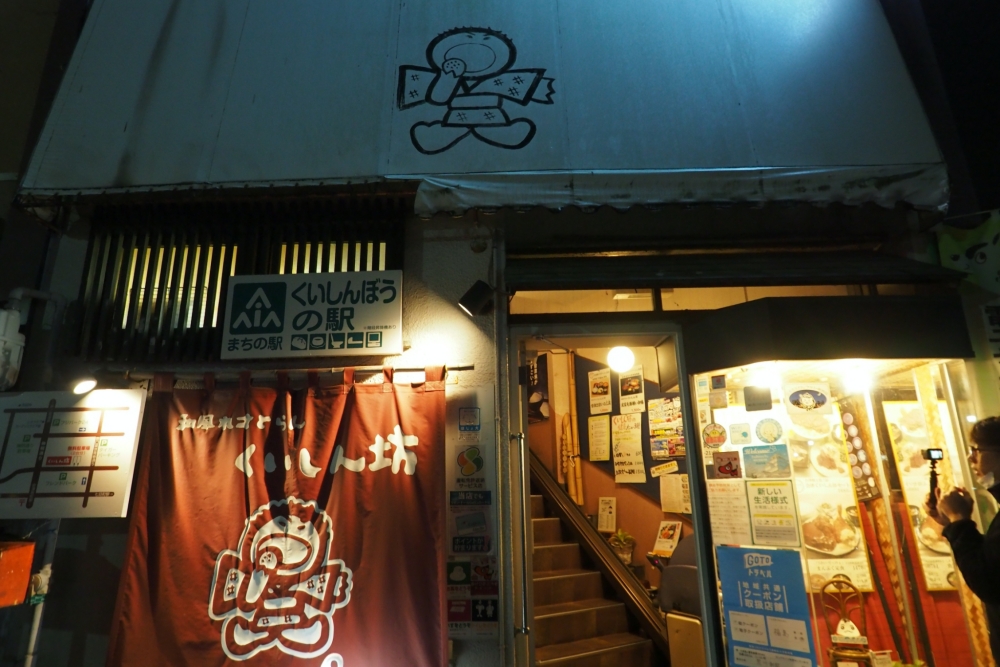
Kuishinbo (Image credit: KrobkruengJapan)
After you’ve had fun touring around, it’s time to try the local Aizu cuisine at Kuishinbo (くいしん坊). The diner is decorated to make you feel at home. There are many meal sets to choose from. And although there are no menus in English, the owner’s English is very fluent, so don’t worry.

Aizu Sauce Katsudon (Image credit: KrobkruengJapan)
As for the local delicacy, I recommend Aizu Sauce Katsudon (会津ソースカツ丼). It is a bowl of rice topped with deep-fried pork cutlet with fresh sliced cabbages and seasoned with Aizu’s special sweet-salty sauce. The set comes with soup, pickled vegetables, pickled fish, and raw horse meat (馬刺し basashi).

Grilled horse meat (Image credit: KrobkruengJapan)
Basashi is another famous dish of this region. We’re not accustomed to raw horse meat, so we asked the cook to grill it for us. The meat tastes delicious indeed—personally I think that it is similar to goat meat. If you have a chance to visit Aizu, be sure to try it out.
Kuishinbo (くいしん坊)
Address: 4-31 Nakamachi, Aizuwakamatsu, Fukushima 965-0878
Access: 15-minute walk from Aizu-Wakamatsu Station (会津若松駅)
Opening hours: 11:00–21:00
The top sightseeing spot: No.1 Tadami River Bridge Viewpoint

View from the No.1 Tadami River Bridge Viewpoint (Image credit: KrobkruengJapan)
Another sightseeing spot that will take your breath away, and is beautiful in every season, is the No.1 Tadami River Bridge Viewpoint—a perfect spot for train lovers and nature lovers alike. This bridge, built in 1946, is a passageway for the local JR Tadami Line (只見線 Tadami-sen) that connects Fukushima Prefecture and Niigata Prefecture.

The viewpoint has a few photo spots at different heights. (Image credit: KrobkruengJapan)
The viewpoint is located near the Ozekaido Mishimajuku Roadside Station. There are three spots where you can take photos—choose the spot you like. The photo spots are viewpoint is a 5-minute walk from the parking lot. Wait for a train to pass by and snap the shot—get photos like these.
No. 1 Tadami River Bridge Viewpoint (第一只見川橋梁展望台)
Access: The No.1 Tadami River Bridge Viewpoint is a 5-minute walk from the Ozekaido Mishimajuku Roadside Station, which is a 10-minute bus ride or 40-minute walk from JR Aizu-Miyashita Station (会津宮下駅).
Admission fee: free

Splendid views from the Tadami Line. (Image credit: KrobkruengJapan)
The JR Tadami Line is a quiet but very scenic line tucked away in the mountains of Aizu. Other than the No.1 Tadami River Bridge Viewpoint, there are many other viewpoints and bridges from which you can gaze at the scenery. Another spot with fantastic views is JR Aizu-Kawaguchi Station. You can also soak in tranquil and scenic views from on board a train on the Tadami Line.

More splendid views from the Tadami Line. (Image credit: KrobkruengJapan)
The surrounding areas are peacefully quiet, and the Tadami River is lined with majestic mountains. Also, there’s onsen to relax, and delicious local foods cooked from local fish and wild vegetables for you to try here.
Farewell to fall, and see you next time!
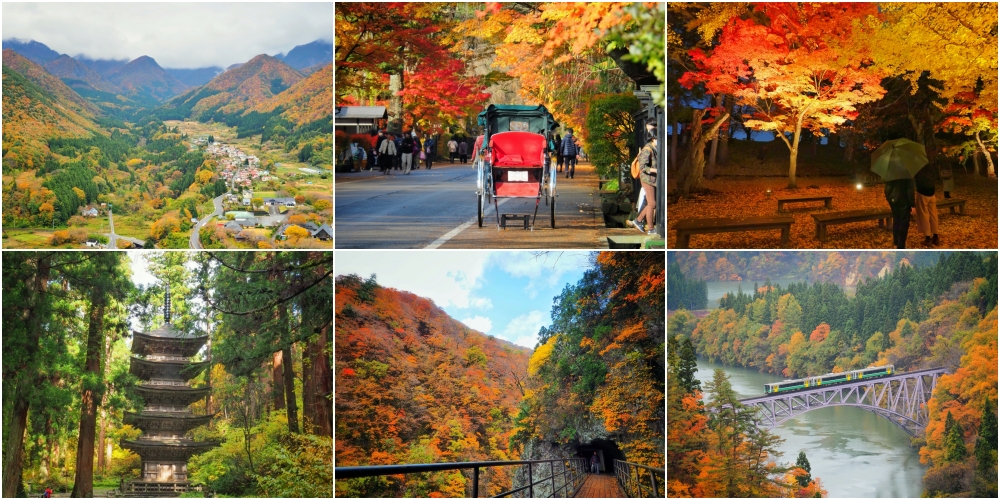
Some of the places we visited on this autumn trip. (Image credit: KrobkruengJapan)
We have come to the end of Part 3 of this series. I hope that our three-part autumn series (Part 1 | Part 2) will help you plan your next visit to Tohoku to catch the beautiful fall foliage. If you have the chance to visit during this season, feel free to check out these places we’ve visited. Though this might have been a short trip, I assure you that it was packed with lots of fun and excitement. See you on the next trip!
JR EAST PASS (Tohoku area)

The JR EAST PASS (Tohoku area) and usage area. (Image credit: JR East)
If you are visiting the Tohoku region, check out the JR EAST PASS (Tohoku area), an affordable pass offering unlimited rail travel on JR East lines (including bullet trains and Joyful Trains) in the valid area for 5 consecutive days at only ¥30,000. And if you are foreign passport holders living in Japan like us, you can also use this rail pass! All foreign passport holders can use the JR EAST PASS (Tohoku area), even those working or studying in Japan.
Header image credit: KrobkruengJapan




